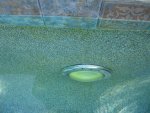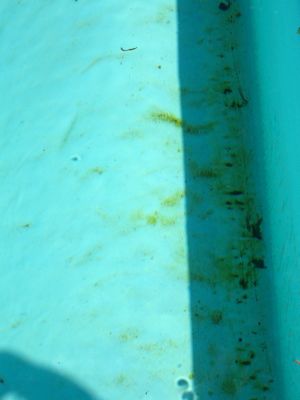My understanding is that if you keep tight pool chemistry (i.e. "balanced water") and keep your pool pretty clean, your pool should not produce much (if any) algae formation. I just bought an elaborate DPD test kit because I was getting some algae again. I have a SWG on a 24,000 gallon "pebble-tek" pool + spa with a DE-60 SF filter and 2-speed pump.
Here are my numbers:
FC: 5+ ppm
CC: 0 ppm
pH: 7.7
TA: 90 ppm
Calcium hardness: 280 ppm
CYA: 35 ppm
Phosphates: 100 ppm
My SWG reads 2700 ppm (although it tested at 3000 ppm at the local pool shop)
The temperature out here in sunny Cal is around 75-85 degrees (pool H2O around 78 degrees) and has been around that temp (70+ days and 60's at night) for about a month with very little ran, wind, etc. I took apart my DE filter a week ago and cleaned and replace all DE. I turn over my water about 1 volume/day which I have always been doing.
I now noticed (about 4-5 days ago) some algae on the east side (sunny-side) of pool. I believe it is green algae and not mustard since it has a greenish hue and sticks primarily to the walls and sides of the seats that face the sun. It sweeps easily with a brush and has no feel (not slimy or gritty, but I do have a pebble coating which may affect the way it feels).
My questions are ...
1) Why did I get algae if all my chemistry is mostly in check? (Maybe I could raise my CYA a bit and lower my pH and chlorine, but my pool chemistry doesn't look bad.) Could it be a circulation problem? I thought algae is mostly influenced by sun, rain, and low chlorine levels and/or phosphates. Does a recent DE cleaning affect this?
2) What algae am I getting? Is it green? What's my best way to get rid of it? Shock it with di-chlor or tri-chlor?
Here are my numbers:
FC: 5+ ppm
CC: 0 ppm
pH: 7.7
TA: 90 ppm
Calcium hardness: 280 ppm
CYA: 35 ppm
Phosphates: 100 ppm
My SWG reads 2700 ppm (although it tested at 3000 ppm at the local pool shop)
The temperature out here in sunny Cal is around 75-85 degrees (pool H2O around 78 degrees) and has been around that temp (70+ days and 60's at night) for about a month with very little ran, wind, etc. I took apart my DE filter a week ago and cleaned and replace all DE. I turn over my water about 1 volume/day which I have always been doing.
I now noticed (about 4-5 days ago) some algae on the east side (sunny-side) of pool. I believe it is green algae and not mustard since it has a greenish hue and sticks primarily to the walls and sides of the seats that face the sun. It sweeps easily with a brush and has no feel (not slimy or gritty, but I do have a pebble coating which may affect the way it feels).
My questions are ...
1) Why did I get algae if all my chemistry is mostly in check? (Maybe I could raise my CYA a bit and lower my pH and chlorine, but my pool chemistry doesn't look bad.) Could it be a circulation problem? I thought algae is mostly influenced by sun, rain, and low chlorine levels and/or phosphates. Does a recent DE cleaning affect this?
2) What algae am I getting? Is it green? What's my best way to get rid of it? Shock it with di-chlor or tri-chlor?




